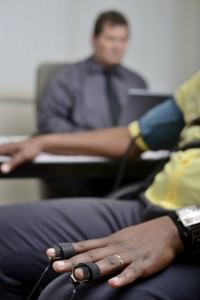FBI Polygraph
 The FBI polygraph takes approximately two to four hours to complete[1] and is generally given in three phases.[2]
The FBI polygraph takes approximately two to four hours to complete[1] and is generally given in three phases.[2]
PRE-TEST PHASE: Following an introduction, initiating an exam, an examine will be asked to sign a consent form stating their willingness to take an FBI polygraph. The examine will also be informed about their right against self-incrimination, as well as the right to speak and consult with an attorney.
The nature and characteristics of the FBI polygraph and the upcoming exam will then be explained. The examine will be told the FBI polygraph [device] is an instrument that measures a person’s physiological responses—a person’s physical/biological responses to questions posed by the examiner using:
- Two pneumograph tubes that are place around your chest and stomach to measure respiration.
- Small cuffs that are attached to your fingertips to measure electro-dermal activity.
- A blood pressure cuff to measure blood flow and heart rate.
- A sensor pad on chair seat to detect movement.
The instrument typically used is a recorder that monitors/records a person’s autonomic arousal, e.g. physiology, using a person’s 1.] heart rate and blood pressure; 2.] respiration; and 3.] skin conductivity. Today examiners use a computerized recording platform. The rate and depth of respiration are measured using a pneumograph wrapped around an examine’s chest, with cardiovascular activity assessed with a blood pressure cuff. Skin conductivity called, “the galvanic skin or electro dermal response,” is measured using electrodes attached to the examine’s fingertips.[3]
Questions used during the FBI polygraph will be reviewed before any test begins, and the examine will be given an opportunity to discuss any concerns and/or ask questions about the process. Questions can only be answered using “yes” or “no” answers. The examiner will also explain being nervous does “not” affect the results of the FBI polygraph … that examiners generally expect people to be nervous. Because everyone is different, the examiner will explain each instrument is tailored to read the examine’s physiology, and thereafter look for changes.
A “stimulation test” will be conducted by the examiner—demonstrating the machine’s accuracy for detecting deception. And the examiner will remind the examine that the FBI polygraph is voluntary, and the examine can terminate the FBI polygraph at any given time.
The pretest phase is designed to ensure that the examine understands the questions, as well as process … and induce a level of concern about being deceptive.
IN-TEST PHASE: During the In-test phase taking the FBI polygraph, the examine will be asked both relevant and non-relevant questions with the examiner analyzing the chart as questions are being asked. This phase takes about five to six-minutes and can be repeated three to six-times.
Several questioning techniques are used by examiners giving a polygraph exam. Accordingly, the most widely used format will be mentioned here:
CONTROL QUESTION TEST – The most widely used test format conducting a criminal investigation is the Control Question Test or CQT format. The CQT format compares responses to “relevant” questions, e.g., “Did you shoot your wife?” … with the “control” questions. The “control” questions are designed to control, what can best be described as, the threatening nature of “relevant” questions. The “control” questions concern misdeeds similar to those being investigated, but concern the “examine” on a much broader in scope, e.g., “Have you ever betrayed anyone’s trust?”
A person telling the truth is presumed to fear “control” questions because it is widely believed the questions arouse concern about “truthfulness,” while “relevant” questions focus on the crime someone presumably did “not” commit. The more physiological responses an examine demonstrates towards “relevant” questions versus “control” questions, an examiner will render an opinion the examine is being “deceptive.” The greater the response to “control” questions, the examine’s test results will be judged as “non-deceptive.” In the event, an examiner cannot differentiate between “relevant” and “control” questions, the test results will be ruled “inconclusive.”[4]
POST-TEST PHASE: If the FBI polygraph is deemed “inconclusive” or worse “deceptive,” an examine might be questioned about a response or responses. Problem questions can be rephrased and/or discussed before the In-Test phase is repeated.
Concluding the FBI polygraph, the examiner will reach a “preliminary” decision regarding the results of the polygraph exam, but the examiner will not discuss his/her decision until the chart has been reviewed and validated by another examiner.
________________________________________________
Directory members can be extremely helpful to anyone seeking information and/or requiring a professional opinion concerning investigations involving the FBI polygraph. Accordingly, looking for information about the FBI polygraph and/or an expert concerning investigations involving an FBI polygraph—please draw upon the website’s search feature, entering the appropriate skill, issue, and/or need, as well as the desired geographical area of preference, and using the information provided, make contact with the listed FBI specialist.
______________________________________________
Retired FBI Agents and Analysts familiar with the FBI polygraph exam and/or are former FBI polygraph examiners, interested in securing a Directory listing and/or a personal email address, should submit an online application requesting membership.
NOTES:
[1] Information and content taken from article captioned, “How to Prepare for a Security Clearance Polygraph Examination,” written by WILLIAM HENDERSON, dated June 6, 2011. at http://news.clearancejobs.com/2011/06/06/how-to-prepare-for-a-security-clearance-polygraph-examination.
[2] It should be noted Applicants seeking employment with the Government will also undergo an exhausting Personnel Security Interview [PSI] before the polygraph exam wherein any issue and/or concern can be asked and addressed.
[3] See section headed, “Findings,” at http://www.apa.org/research/action/polygraph.aspx.
[4] See section headed, “Findings,” and Control Question Test at http://www.apa.org/research/action/polygraph.aspx.
